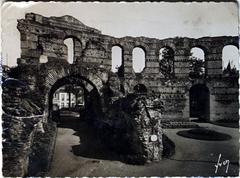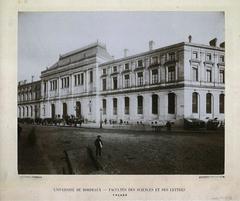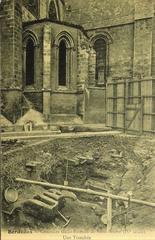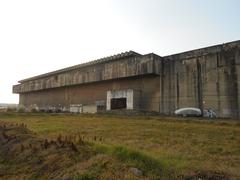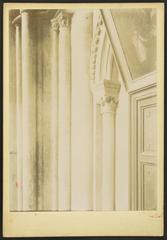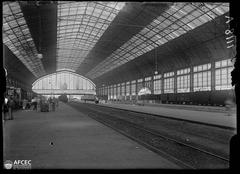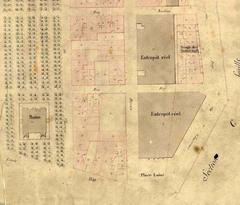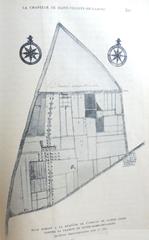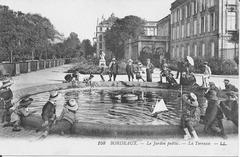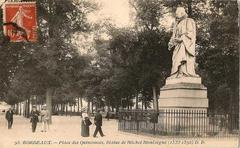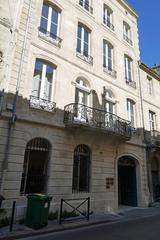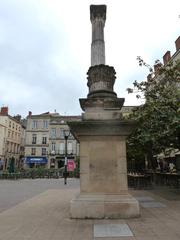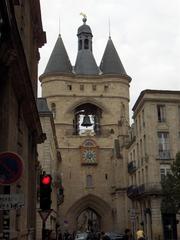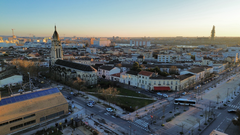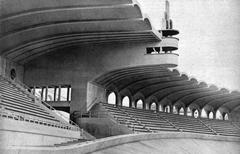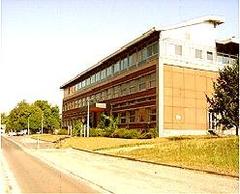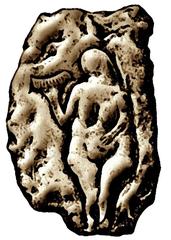
Fort du Hâ: Visiting Hours, Tickets, and Bordeaux’s Historic Fortress
Date: 04/07/2025
Introduction
Fort du Hâ, also known as Château du Hâ, is one of Bordeaux’s most significant historical sites. Built in the mid-15th century, the fortress has witnessed the city’s transformation from a medieval stronghold to a center for justice and memory. Today, its surviving towers stand as enduring symbols of Bordeaux’s layered past, offering visitors insight into the city’s evolution through war, revolution, repression, and modernity. This comprehensive guide provides detailed information on visiting hours, ticketing, accessibility, guided tours, nearby attractions, and the historical and cultural context necessary for planning a rewarding visit to Fort du Hâ.
Table of Contents
- Historical Overview
- Visiting Fort du Hâ: Practical Information
- Cultural and Urban Significance
- Frequently Asked Questions
- Summary and Visitor Tips
- Sources and Further Reading
Historical Overview
Origins and Construction
Commissioned in 1456 by King Charles VII following the French victory at the Battle of Castillon and the end of English rule in Bordeaux, the Fort du Hâ was constructed to both defend the city and assert royal authority over a population with deep ties to the English crown. Its formidable walls—up to 4.4 meters thick in the Minimes Tower—were intended as a clear signal of royal power (Wikipedia; Chateaux de France). Strategically sited near Bordeaux’s western ramparts, the original fortress featured two main towers—Tour des Anglais and Tour des Minimes—which remain today as listed historic monuments (Guide Bordeaux Gironde).
Shifting Roles: Ducal Residence and Urban Authority
In 1470, the fortress became the residence of Charles de Valois, Duke of Guyenne and brother to King Louis XI, serving briefly as a ducal palace and courtly center until his death in 1472 (Wikipedia). Beyond its military function, Fort du Hâ was a potent tool for keeping Bordeaux’s sometimes rebellious citizens under control—epitomized by the phrase “tenir aux Bordelais le fer au dos.” The fortress was pivotal during episodes such as the 1548 gabelle (salt tax) revolt and the Fronde, when its walls sheltered royal officials and garrisons (Wikipedia).
Decline, Prisons, and State Repression
By the 18th century, the fort’s military value had faded, and in 1731 it was converted into a prison (Vieux Bordeaux). Its notoriety grew during the French Revolution and again in the 19th and 20th centuries as a center of incarceration and repression. In World War II, Nazi occupiers used Fort du Hâ to detain, interrogate, and torture political prisoners and resistance fighters (Rue89 Bordeaux; Spotting History). A memorial plaque now commemorates those who were interned and executed, particularly the twenty resistance members taken to Camp de Souge and executed in 1941 (Fusillés Souge).
The prison continued to function until its closure in 1967 and partial demolition in 1969 (Spotting History).
Twentieth Century: From Prison to Judicial Complex
In the 1970s, the site was transformed yet again, becoming home to the École Nationale de la Magistrature (ENM), France’s National School for the Judiciary. In 1998, the modern courthouse designed by Richard Rogers was added, juxtaposing contemporary architecture with the medieval towers. The Fort du Hâ’s remaining towers and fragments of wall are now protected as Monuments Historiques (Chateaux de France), symbolizing both continuity and renewal in Bordeaux’s civic landscape.
Visiting Fort du Hâ: Practical Information
Location and Access
Fort du Hâ is centrally located in Bordeaux, adjacent to the Palais de Justice and the ENM. The nearest tram stop is “Palais de Justice” (Tram A), less than five minutes’ walk away. Public transport is recommended due to limited parking and pedestrian zones (France-Voyage).
Address:
École nationale de la magistrature
10 Avenue Thiers, 33000 Bordeaux, France
Visiting Hours & Admission
- Exterior Viewing: The towers and exterior of Fort du Hâ can be viewed at any time from the public streets surrounding the ENM and the Palais de Justice.
- Interior Access: The interior is only accessible during special events, such as European Heritage Days in September, or on guided tours arranged by local heritage groups (France-Voyage).
- Admission Fees: No fee is charged for exterior viewing. Special tours or events may require advance booking and may have a fee.
- Contact for Tours: For up-to-date details and tour reservations, contact the ENM at +33 (0)5 56 00 66 00.
Guided Tours and Visitor Tips
- Guided Tours: Available during heritage events or by prior arrangement with local associations. These tours may provide rare access to the interior and detailed historical context.
- Best Times to Visit: Early morning or late afternoon on weekdays for a quieter experience. European Heritage Days offer the best opportunity for comprehensive visits.
- Booking: Advance booking for tours is strongly recommended due to limited availability.
Accessibility
- Exterior Areas: Flat, well-maintained pavements around the site are accessible for visitors with limited mobility.
- Interior Access: The towers’ interiors, when open, may involve stairs and are not fully wheelchair-accessible.
Nearby Attractions
- Palais de Justice: Notable for its modern architecture by Richard Rogers.
- Place Pey Berland: Home to Bordeaux City Hall and Saint-André Cathedral, a short walk away.
- Restaurants and Cafés: Numerous options in the area, from casual to fine dining.
- Other Landmarks: Visit the Place de la Bourse, Musée des Beaux-Arts, and Hôtel de Ville for a full day of historical exploration.
Photography and Language Support
- Photography: The exterior can be freely photographed. If granted interior access, confirm photography policies on site.
- Languages: Interpretive signage is primarily in French; English translations are available on some panels. Translation apps or guidebooks are helpful for non-French speakers.
Cultural and Urban Significance
Fort du Hâ is more than a relic; it is a living symbol of Bordeaux’s resilience and adaptability. Its imposing towers evoke the city’s role in pivotal moments of French history—from the end of the Hundred Years’ War to the traumas of the Revolution and World War II (FranceRent; Bouger à Bordeaux). The site’s transformation from fortress to prison, and now to a center of legal education, mirrors Bordeaux’s ongoing journey from the medieval era to the modern day.
The integration of medieval and contemporary architecture at the site reflects the city’s commitment to honoring its heritage while embracing the future. The memorials and interpretive signage ensure that the darker chapters of Fort du Hâ’s story remain part of the city’s collective memory.
Frequently Asked Questions
Q: Can I visit inside Fort du Hâ?
A: Interior access is generally restricted, but guided tours or special openings may be available during European Heritage Days or by arrangement.
Q: Are there guided tours?
A: Yes, during heritage events or by booking through the ENM or Bordeaux Tourist Office.
Q: Is there an admission fee?
A: No fee for exterior viewing. Special tours may have a fee.
Q: Is the site accessible for visitors with reduced mobility?
A: Exterior areas are accessible; interior access may be less so.
Q: What are the nearest public transport options?
A: “Palais de Justice” (Tram A) is the closest tram stop.
Q: Are there memorials on site?
A: Yes, notably the Mémorial de la Déportation, honoring WWII resistance victims (Fusillés Souge).
Summary and Visitor Tips
Fort du Hâ encapsulates Bordeaux’s historical evolution, from medieval fortress to judicial institution and site of remembrance. While regular interior visits are not possible, the towers and external grounds are accessible year-round, making this an ideal stop for history and architecture enthusiasts. Plan your visit during European Heritage Days for the fullest experience, and combine your exploration with nearby landmarks for a comprehensive tour of Bordeaux’s rich past.
To enhance your visit, download the Audiala app for audio guides and real-time updates on Bordeaux attractions, and follow official social media channels for news on upcoming events and openings.
Visuals and Maps
Alt text: Fort du Hâ towers showcasing medieval stonework in Bordeaux
Alt text: Map pinpointing Fort du Hâ near Palais de Justice in Bordeaux
Sources and Further Reading
- Fort du Hâ, 2024, Bordeaux.fr
- Le saviez-vous ? Le Fort du Hâ était l’ancienne prison de Bordeaux, 2023, Sud Ouest
- Château du Hâ, 2024, Wikipedia
- Château du Hâ, 2024, France-Voyage
- Fort du Hâ - Lieu d’internement et de répression, 2024, Fusillés Souge
- Fort du Hâ, 2024, Spotting History
- Chateaux de France
- Guide Bordeaux Gironde
- Vieux Bordeaux
- Rue89 Bordeaux
- FranceRent
- Bouger à Bordeaux







